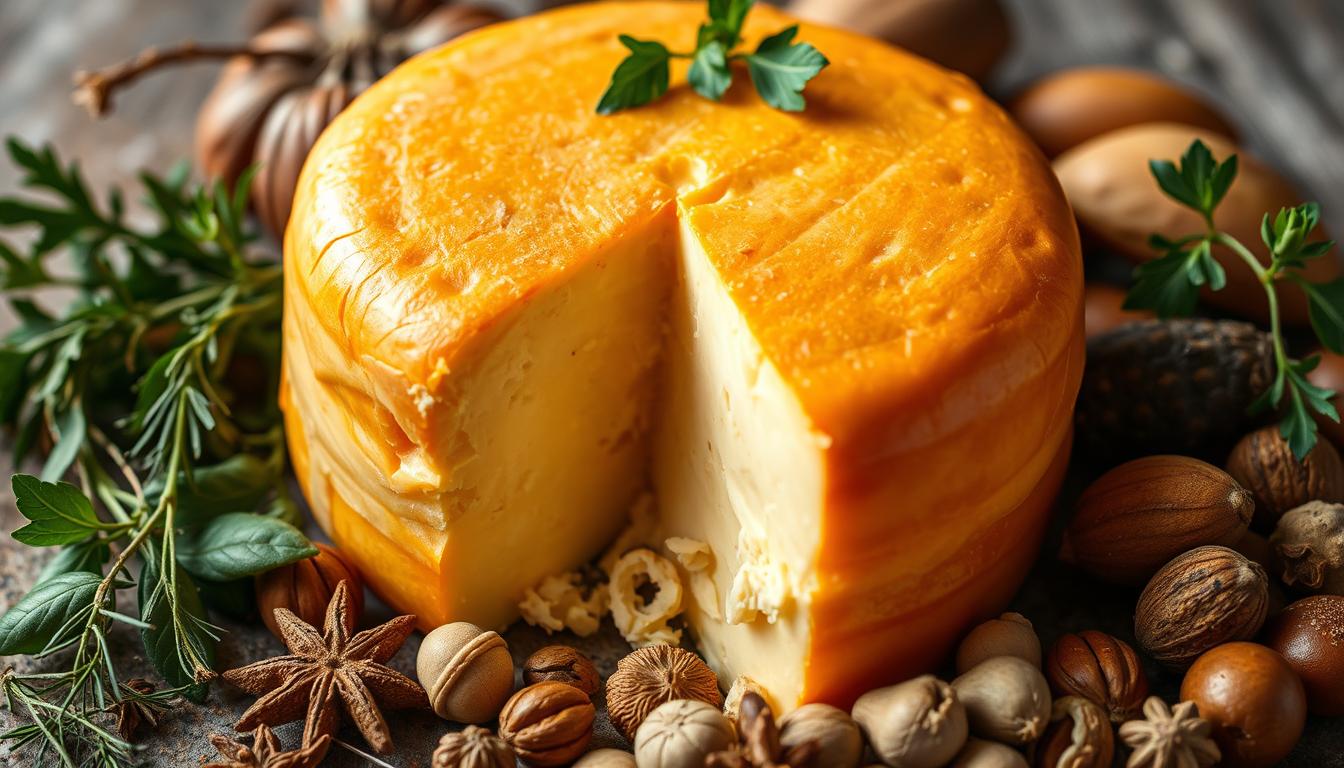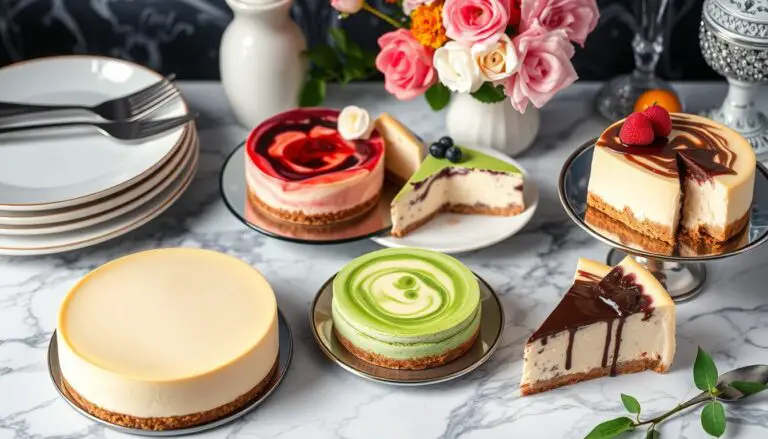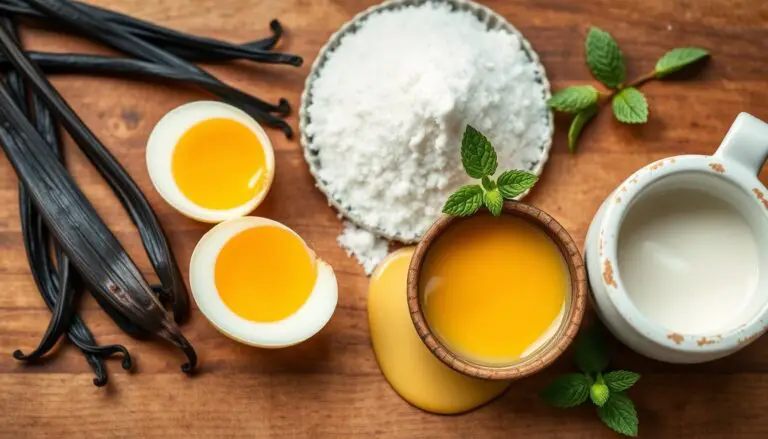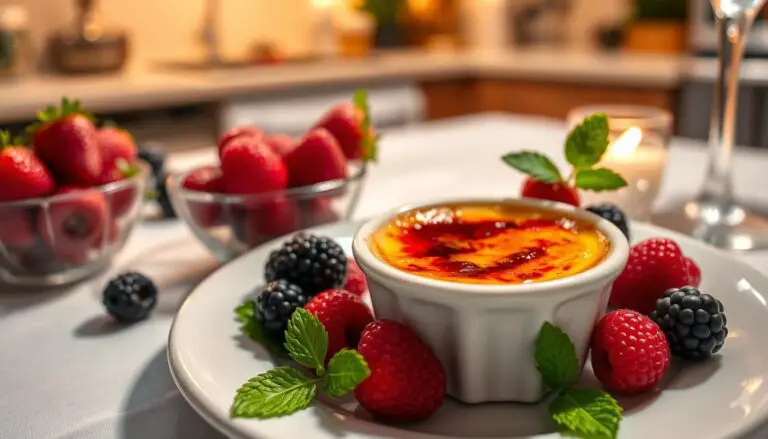Discover the Unique Flavor of Munster Cheese
Munster cheese comes from the Alsace region of France. It’s loved for its special taste and smell. Its creamy texture and strong flavor make it a favorite in cooking.
Monks have made this cheese since the 7th century. It shows the rich history and skill of its makers. Munster cheese’s unique taste captures its heritage, making it a must-have in many homes.
The making of Munster cheese is a big part of Alsace culture. It has a strong smell and a sticky orange rind. This cheese is loved for its unique taste.
If you’re interested in cheese, check out this [article](https://www.bbcviral.com/) for more info.
Key Takeaways
- Munster cheese is known for its creamy texture and robust flavor.
- This semi-soft cheese has historical significance, dating back to the 7th century.
- Its distinct aroma and unique characteristics set it apart from other cheese varieties.
- The cultural heritage of Munster influences its production and enjoyment today.
- Versatile in the kitchen, it’s used in a variety of dishes.
Introduction to Munster Cheese
Munster cheese is a tasty semi-soft cheese loved by cheese fans everywhere. It comes from the Alsace region of France, made by about 40 local farmers1. Unlike Muenster cheese from America, Munster is made with unpasteurized milk2. This gives it a stronger taste.
The aging process is about two months. This makes its orange rind and pale yellow to light red inside stand out3.
Munster cheese has a bold flavor, with hints of mushroom and garlic. It’s perfect for those who like strong tastes2. It’s also high in fat and protein, but it’s best to eat it in small amounts3.
It’s a favorite in many dishes, thanks to its unique smell and feel. Munster cheese has a rich history in French dairy farming. It adds a special touch to cheese platters and recipes.
The Rich History of Munster Cheese
The history of Munster cheese goes back to the 7th century. It started in the Alsace region of France, thanks to Italian monks. Over time, cheese-making traditions have changed, influenced by the land and local needs. Munster cheese’s story is tied to the area’s farming, showing its culinary heritage.
Fresh milk from local farms is key to its taste. The cheese ages in humid cellars for weeks. This process makes its bold flavor and strong smell, typical of Munster cheese4. Its quality is recognized globally, earning it a special status in Europe5.
Munster cheese is more than just cheese. It’s a cultural treasure, showing centuries of community values. Its ongoing tradition is a tribute to French cheese-making skill, kept alive by each new generation4.
| Characteristic | Description |
|---|---|
| Origin | Alsace region of France |
| Milk Type | Fresh cow’s milk from local dairy farms |
| Aging Process | Aged in humid cellars for several weeks |
| Flavor Profile | Bold flavor with a pungent aroma |
| Protected Status | Protected designation of origin |
What does Munster cheese taste like?
Munster cheese offers a unique taste journey. It starts with a creamy, buttery flavor that deepens with age. As it matures, it picks up hints of garlic and spices, ending with a tangy finish6.
Exploring the Flavor Profile
Munster cheese has a semi-firm texture and a mild aroma that gets stronger over time. Young Munster is smooth and mild, perfect for many dishes. As it ages, its flavor becomes more intense, loved by cheese lovers6.
The cheese gets its orange color from annatto, adding a nutmeg-like taste. This makes Munster cheese complex and interesting6.
Comparative Tastes: Young vs Aged Munster
Young Munster is great for sandwiches and charcuterie, with its mild taste. Aged Munster, on the other hand, is sharp and pungent, perfect for bold dishes and wines6.
Knowing the difference helps you choose the right Munster for your recipes. Whether in a grilled cheese or gourmet dishes, Munster cheese always impresses.
| Munster Type | Taste Profile | Texture | Cooking Uses |
|---|---|---|---|
| Young Munster | Mild, creamy with buttery notes | Semi-soft | Grilled cheese, charcuterie |
| Aged Munster | Sharp, pungent, tangy | Firm | Mac and cheese, gourmet dishes |
Munster cheese is versatile, fitting well with many flavors. It’s loved in casual and fancy meals. For more about Munster cheese, visit here6.
The Aromatic Qualities of Munster Cheese
Munster cheese is famous for its strong smell. This smell can make people either love or dislike it. The Munster cheese aroma is very distinct, making it stand out in the world of cheese. This smell comes from the bacteria used to make it, which adds to its rich and aromatic taste over time.
Understanding Munster Cheese Aroma
Munster cheese is made with special bacteria that give it its smell. Brevibacterium linens is key in creating its strong scent. As the cheese ages, its smell gets even stronger, becoming more complex and earthy.
The Role of Bacteria in Aroma Development
Bacteria in cheese are important for its taste and smell. In Munster cheese, the bacteria help develop its flavors and smells. The age and type of bacteria used make Munster cheese unique, interesting to both chefs and cheese lovers.
| Bacterial Strain | Role in Flavor Development | Aroma Characteristic |
|---|---|---|
| Brevibacterium linens | Contributes to pungency | Earthy, strong scent |
| Lactococcus lactis | Aids in fermentation | Slightly tangy |
| Penicillium candidum | Enhances flavor maturation | Complex, creamy |
Knowing about the bacteria in cheese helps us appreciate Munster cheese more. As it ages, its smell and taste get even better, keeping it a favorite in cooking and eating78.
Distinctive Textures of Munster Cheese
Munster cheese is known for its semi-soft texture. It has a creamy yet slightly grainy feel. This is due to the aging process, which changes how it tastes and feels.
Semi-Soft vs Other Cheese Textures
Munster cheese is smooth and semi-soft. It’s easy to slice and melt, making it great for cooking. Hard cheeses, like Parmigiano-Reggiano, are firm and crumbly. Knowing these differences helps us enjoy the variety in cheese textures.
| Cheese Type | Texture | Moisture Content |
|---|---|---|
| Munster | Semi-Soft | High |
| Cheddar | Firm | Medium |
| Brie | Soft | High |
| Parmesan | Hard | Low |
How Aging Influences Texture
The aging process changes Munster’s texture. Young Munster is creamier and softer. As it ages, it loses moisture, becoming firmer and more complex.
This change makes aged Munster a favorite for those who love strong flavors and textures.
Munster Cheese: A Stinky Delight
Munster cheese is known for its strong smell, making it a stinky cheese. People have different reactions to its scent. Some love it, while others find it too much.
The cheese’s smell comes from a special aging process. This process uses Brevibacterium linens, a bacterium that adds to its smell and taste. The cheese is washed with brine that has this bacterium, making it even more pungent9.
Why Munster is Considered Stinky Cheese
Munster cheese is indeed known for its strong smell. It has a creamy texture and a scent that can be both appealing and overwhelming. Its unique qualities come from traditional methods used since the Middle Ages9.
The aging process, lasting about 10 to 14 days, helps the cheese develop its full flavor10.
The Cultural Perception of Strong Smelling Cheeses
In Europe, strong smelling cheeses are celebrated for their complex flavors. Communities see these cheeses as part of their culinary heritage. They use them to make dishes even more special.
A Petit Munster soufflé is a local favorite that shows how much people appreciate this cheese. It highlights how Munster’s creamy and pungent nature can make dishes better Munster cheese is a great example of how cultural views on strong smelling cheese can make food experiences richer9.
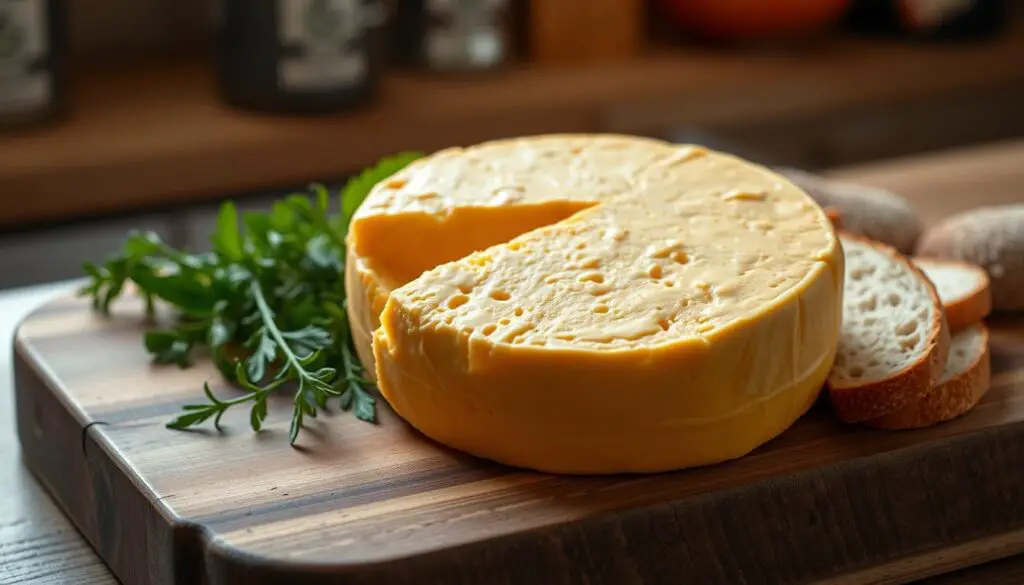
How Munster Cheese is Made
The making of Munster cheese starts with picking raw, unpasteurized cow’s milk. This milk is key for the cheese’s true taste and smell. Next, rennet and special bacteria are added to the milk. These cause it to turn into curds, which is typical for Munster cheese.
After the curds form, they are cut, drained, and pressed. This step is important for Munster cheese’s unique texture. Then, the cheese ages. During this time, it’s brushed with salt water to grow good bacteria on the rind. This step boosts the flavor and smell of the cheese.
Making Munster cheese is a detailed and complex process. It combines old methods with new food science. Factors like temperature, humidity, and time are crucial for its taste. This ensures every batch is a delicious experience1112.
Culinary Uses of Munster Cheese
Munster cheese is very versatile in cooking. It has a mild yet complex flavor. This makes it great for pairing Munster cheese with many foods. It’s perfect for both simple and fancy dishes.
From creamy mac and cheese to fancy charcuterie boards, Munster cheese has many uses. Its creamy and buttery taste, with a slight tanginess, is perfect for different foods.
Pairing Munster with Foods
This semi-soft cheese is great with fruits like apples and grapes. It also pairs well with savory foods like cured meats and crusty bread13. The mix of flavors is exciting.
Its texture makes it easy to melt. This is great for adding creaminess to cooked dishes.
Versatile Recipes Featuring Munster Cheese
Munster cheese is great in many recipes. Try making a Munster cheese soufflé or a grilled cheese sandwich. It melts beautifully.
It’s also good in quesadillas or as a pasta topping. Munster cheese can be stored in the fridge for two to three weeks14. Its melting quality is perfect for quick meals.
Enjoying it on a cheese platter is another great way to experience its flavor.
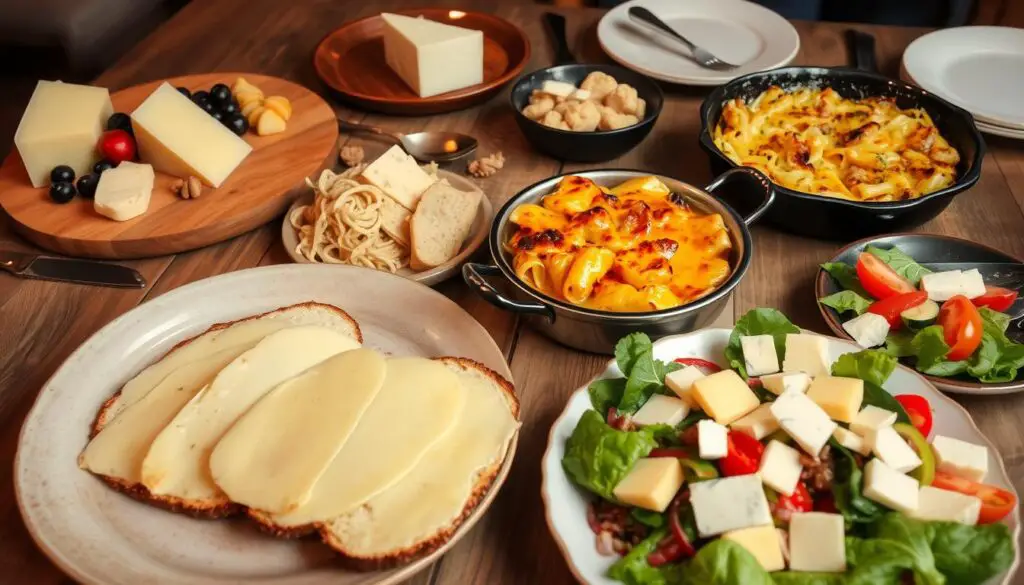
| Recipe | Main Ingredients | Culinary Use |
|---|---|---|
| Munster Cheese Soufflé | Eggs, milk, Munster cheese, butter | Baked dish highlighting the cheese’s melting qualities |
| Grilled Cheese Sandwich | Bread, Munster cheese, butter | Classic comfort food showcasing the cheese melting |
| Quesadilla | Tortilla, Munster cheese, beans, peppers | Melted cheese enchancing the richness of each bite |
Munster cheese is charming, whether enjoyed alone or in recipes. It adds taste and texture to many dishes1413.
The Global Influence of Munster Cheese
Munster cheese comes from Alsace and Lorraine in France. It has become well-known around the world. Its unique taste has inspired many to make their own versions, showing Munster’s global impact.
Comparisons with Other International Cheeses
French cheeses like Brie de Meaux and Camembert de Normandie are famous. They show the variety and tradition of French cheese. Munster cheese, with its strong flavor, is also a favorite. It’s different from the milder American version, but both are loved globally15.
The Spread of Munster Cheese Variants
Munster cheese has spread to other countries, leading to new versions. In the U.S., muenster cheese has 368 calories, 30 grams of fat, and 717 mg of calcium per 100 grams16. These changes make it more appealing to many. The rise in popularity of these versions shows people’s love for unique tastes in food.
Conclusion
Munster cheese is known for its rich flavors and vibrant aroma. It has a unique texture that sets it apart from other cheeses. Cheese lovers can enjoy it in many ways, from simple platters to complex recipes.
It’s packed with about 7 grams of protein per ounce. It also has important vitamins like B12, riboflavin, and niacin. This makes it great for both taste and nutrition17.
The history and craftsmanship of Munster cheese are fascinating. It can last 3-4 weeks in the fridge and up to 3 months in the freezer. This makes it a convenient choice for cheese fans18.
Enjoying Munster cheese is more than just eating. It’s about savoring each bite. Whether you pair it with other foods or enjoy it alone, it’s a special experience.

